Emydura subglobosa subglobosa (Krefft, 1876)
Painted Turtle
Pleurodira-> Chelidae -> Emydura -> Emydura subglobosa -> Emydura subglobosa subglobosa
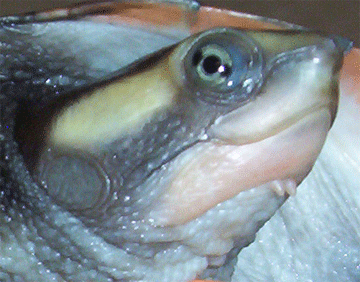
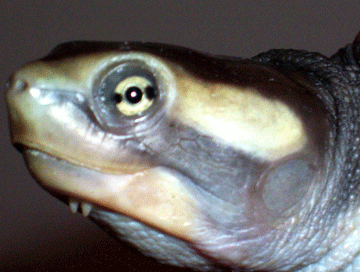
|
Head
| The head is relatively robust. The top of the head is dark brown while the bottom of it is cream or light grayish with a sign of pink/orange colour which fades away as animals mature. There is a stripe of each side of the head that runs past the eye to the nose. "The base colour of the stripe can be cream, yellow or salmon pink and this depends largely on where they are from." (Thomson S., 2003) According to Scott Thomson, the stripe always has a black border (sometimes hard to see due to the dark background)*. The jaws are strong designed to break mussels and other mollusc even though the symphysis is not as expanded as in other Emydura species.
As for the eye, the E. subglobosa has a blue iris with a black pupil and the species has the leading and trailing eye spots.
There are two barbells on the chin**. Macrocephaly is not well developed in the Emydura subglobosa species.
* I have examined the male on the picture and found no trace of the black border.
** The function of these barbells is unknown to me. |
|
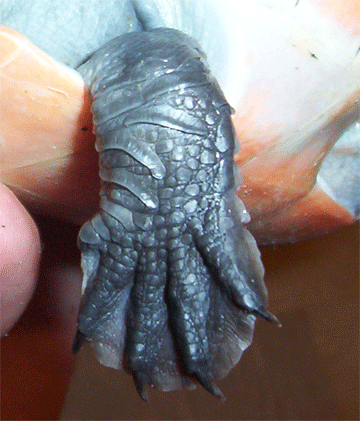 |
Fore limbs
|
There are five* claws on each of the webbed forelimbs. The colour of the forelimbs is dark gray with some orange or pink markings** on the inner side. The fore limbs are used for swimming and leaning against floating water plants or hard material (stones, wood fallen into water, tree roots at the water surface level, etc.) when either resting or sunbathing.
* The limb on the picture has just 4 claws. When I acquired specimen as a juvenile (CL at that time: 5.8 cm), the damage was already present, but I assume it was caused (bitten off) by one of the other animals it was kept with.
** These markings fade as turtles mature and might disappear completely. |
|
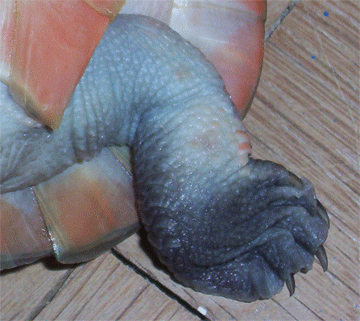 |
Hind limbs
|
The hind limbs are gray with some orange or pink markings* on the inner side. There are 4 claws on each rear limb. They are webbed and are used for both paddling and steering. Due to its strong and webbed limbs, the Emydura species is an excellent swimmer.
Scott Thomson chased them...
*These markings fade as turtles mature and might disappear completely. |
|
 |
Tail
|
The tail is dark gray on top and light gray on bottom. Just like with the majority of all turtles, males have longer and thicker tales with the cloaca located behind the carapace rim. The tail on the picture is a tail of my semi adult male. |
|
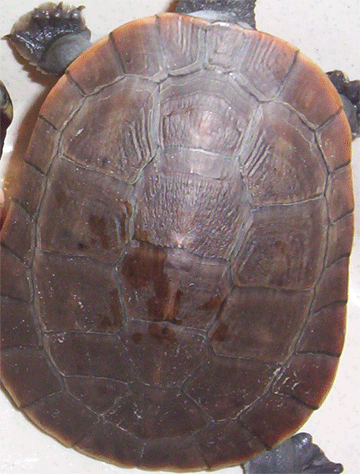 |
Carapace
|
The nuchal scute is quite small. There are 11 marginal scutes* on each side of the carapace (22 altogether), 5 vertebral scutes (the 2nd vertebral scute being the biggest) and 4 costal scutes on each side (8 altogether)**
Carapace Scheme
The colour of carapace is brown to dark brown sometimes with an orange rim going round the outer edge of the marginal scutes.
* Notice the specimen on the photo has 11 marginal scutes on the right and 12 marginal scutes on the left (I have not seen this abnormality in any other specimen).
** Notice the specimen on the picture has one of its costal scutes split into 2 scutes (the last costal scute on the left), which makes this specimen abnormal with 9 costal scutes. I have no idea whether this defect is a result of mechanical damage or the specimen already hatched with this defect, but it was present when I acquired the specimen as a juvenile (CL at that time: 5.8 cm). |
|
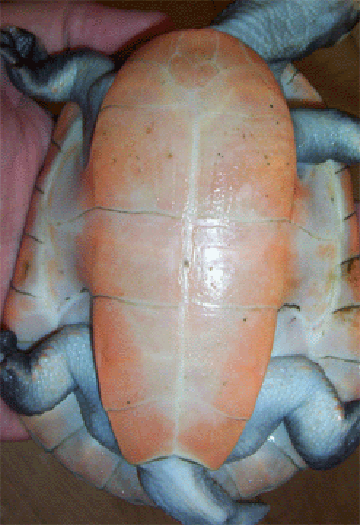 |
Plastron
|
The plastron is oval being widest at the pectoral region and narrowing towards the anal region. The gular shields of the plastron are entirely separated by the intergular, and the latter does not come into contact with the pectorals.
Plastron Scheme
The bridge is attached to the pectoral and abdominal shields on each plastron side.
The colour of the carapace is orange or salmon pink, darker towards edges and paler towards the middle. The colour tends to fade away as animals mature but the colour tone range and the speed at which the colour changes varies from specimen to specimen*.
* The colour variations may be diet dependent, but I have not come across a source that would either confirm or disagree with this theory. |
|








